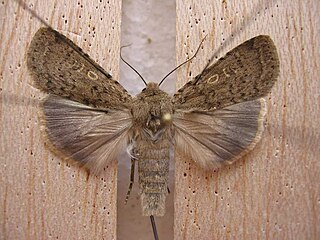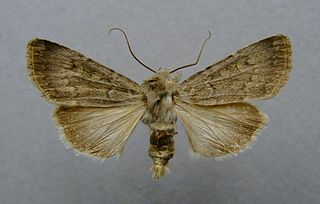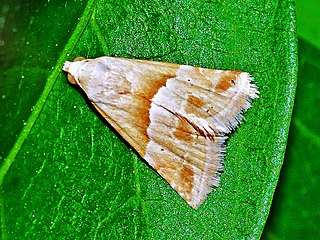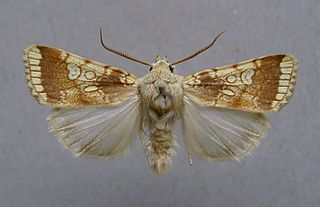
The ingrailed clay is a moth of the family Noctuidae. The species was first described by Johan Christian Fabricius in 1775. It is distributed through most of Europe and the Palearctic.

The Gothic is a moth of the family Noctuidae. The species was first described by Carl Linnaeus in his 1758 10th edition of Systema Naturae. It is distributed in temperate Eurasia, in the Palearctic realm, including Europe, Turkey, Iran, Caucasus, Armenia, Transcaucasia, Central Asia, Altai mountains, and west and central Siberia.

The dot moth is a moth of the family Noctuidae. The species was first described by Carl Linnaeus in 1761. It is a very distinctive species with very dark brown, almost black, forewings marked with a large white stigma from which the species gets its common name. The hindwings are grey with a dark band at the termen. The wingspan is 38–50 mm. It flies at night in July and August and is attracted to light, sugar and flowers.

Conistra ligula, the dark chestnut, is a moth of the family Noctuidae. The species was first described by Eugenius Johann Christoph Esper in 1791 and it is found in the Palearctic.

Orthosia cruda, the small Quaker, is a moth of the family Noctuidae. It is found in Europe, Morocco, Algeria, Tunisia, Turkey, the Caucasus, Transcaucasia, Kazakhstan, Israel, Lebanon, Cyprus and Jordan.

The Sprawler(Asteroscopus sphinx) is a moth of the family Noctuoidea. It is found throughout western Europe, but is mainly a Northern species occurring South to Northern Spain the southern edge of the Alps, Central Italy and Northern Greece. North to southern Sweden. East to Kaliningrad and Moscow. Also in Central Europe, Turkey, the Caucasus and Asia Minor.

Xestia baja, the dotted clay, is a species of moth of the family Noctuidae. It is found in Europe, Turkey, northern Iran, Transcaucasia, the Caucasus, central Asia, Siberia, Mongolia, Tibet, China, Korea and Japan.

Autographa jota, commonly known as plain golden Y, is a moth of the family Noctuidae. The nominate form is found in Europe. while the subspecies Autographa jota anatolica is found in the southern Balkans, south-western Asia, Turkey, the Caucasus, and north-western Iran.

Epilecta linogrisea is a moth of the family Noctuidae. It is found in Central and Southern Europe, Algeria, Morocco, the Caucasus, Armenia, Turkey, North-Western Iran, Syria, Israel and Lebanon.

Chersotis cuprea is a moth of the family Noctuidae.

Chersotis multangula is a moth of the family Noctuidae. It is found in the mountainous areas of Central and Southern Europe, Morocco, Turkey, Armenia, Iran, Syria, Lebanon and the Caucasus.

Agrotis cinerea, the light feathered rustic, is a moth of the family Noctuidae. The species was first described by Michael Denis and Ignaz Schiffermüller in 1775. It is found in southern and central Europe, northern Turkey, the Caucasus, western Turkmenia and Central Asia.

Dichagyris musiva is a moth of the family Noctuidae. It is found in some mountainous areas of Europe, Turkey, Armenia, the Caucasus, Anatolia, southern Siberia, Mongolia, Tibet and western China.

Globia algae, the rush wainscot, is a moth of the family Noctuidae. The species was first described by Eugenius Johann Christoph Esper in 1789. It is found in central and southern Europe, Turkey, Armenia, northern Caucasus, south-west Siberia.

Rhyacia simulans, the dotted rustic, is a moth of the family Noctuidae. The species was first described by Johann Siegfried Hufnagel in 1766. It is found in most of Europe, south to Morocco, Algeria and Tunisia, east to Turkey, the Caucasus, Tomsk and Minusinsk.

Euxoa decora is a moth of the family Noctuidae. It is found in southern and central Europe, Morocco, Algeria, the Caucasus, Armenia, Issyk-Kul, Turkey, Iran and Iraq.

Epipsilia grisescens is a moth of the family Noctuidae. It is found in Fennoscandia, Denmark as well as the Pyrenees, Alps, Apennines, Balkans and Carpathians. In the Alps it is found up to 2,000 meters.

Barrett's marbled coronet is a species of moth of the family Noctuidae. It is found from France through south-eastern Europe to Central Asia. In the north it is found up to the Baltic region. It is also present in North Africa.

Eublemma parva, the small marbled, is a moth of the family Erebidae. The species was first described by Jacob Hübner in 1808.

The heart moth is a species of moth of the family Noctuidae. It is found locally in Europe. It is also present in Turkey, Transcaucasia, the Caucasus, Israel, Iran and Iraq.




















